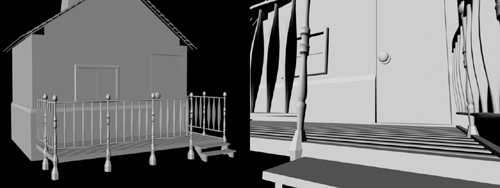Cameras and Perspective
| |
Cameras and PerspectiveThe camera's positioning can imply certain characteristics or traits about the subject. The camera can be close to or far from the subject. It could be under the subject looking up or above the subject looking down. In addition, cameras ”both real and virtual ”have a field of view or, as it's called in Maya, angle of view . That means the camera can be wide-angle or telephoto . The viewer's perception is the intensity of the perspective effect; that is, as the camera views a wider field, the perspective becomes more exaggerated. Normal human vision applied to a typical viewing plane (TV, movie screen) uses a roughly 50-degree viewing angle. Larger angle values view a wider area and produce a stronger, more exaggerated perspective effect, and vice versa, as shown in Figure 1.8. Figure 1.8. Angle of view and apparent perspective: On the left is a 20-degree angle of view, and on the right, an 85-degree angle of view. Angle of View and PerspectiveRelative height can imply importance. For example, if you want your subjects to look mighty , you photograph them from underneath, as though looking up at a giant statue. To create a lonely or isolated effect, you can photograph the subject from above at some distance. Perspective implies drama and action. You may have noticed that sleek cars and planes are sometimes photographed from the front at an extremely wide angle quite close to the vehicle body. This gives a wildly exaggerated perspective, as though the vehicle is coming right at you. Telephoto views at a very low angle value diminish perspective until the objects in view are so flattened that it's hard to tell which objects are closer. The lack of perspective tends to give a sterile, "schematic view" look to your scene. Perspective can also impart a sense of scale. Because 3D worlds have no reference point for size, sometimes it's difficult to communicate whether you're looking at a toy car, a normal full- sized car, or a giant car. There are many cues to size, such as the intensity and size of details in a surface (for a car, scratches, metallic flake, and dirt). Using a wider angle lens is an easy way to impart scale quickly, however. Be careful not to overdo it; generally , angles should range from 25 to 80 degrees. For closeups, you are usually better off with a narrower angle on a camera that's farther away because putting a standard or wide-angle camera very close to an object always results in exaggerated perspective, as shown in Figure 1.9. Figure 1.9. Same subject, but different camera position and angle of view. Vanishing Points and PerspectiveRenaissance-era artists began to realize the key to realistic landscape painting when they discovered the vanishing point . An image can have one, two, or three vanishing points, depending on the camera's orientation. If the camera is perfectly level, only a single vanishing point is apparent. If the camera is rotated left or right (the camera in Figure 1.10 was rotated left), you get a second vanishing point. If the camera is then rotated up or down, a third vanishing point is introduced. Figure 1.10. Using 1-, 2-, and 3-point perspective. In some cases, you might need to position the camera in a place that forces 2-point perspective, but you want only one vanishing point. This often happens in architectural images, when you don't want the buildings to appear to converge at the top, but do want to render the building from a low point of view. Maya can solve this problem with a camera attribute called film offset . |
EAN: 2147483647
Pages: 201


